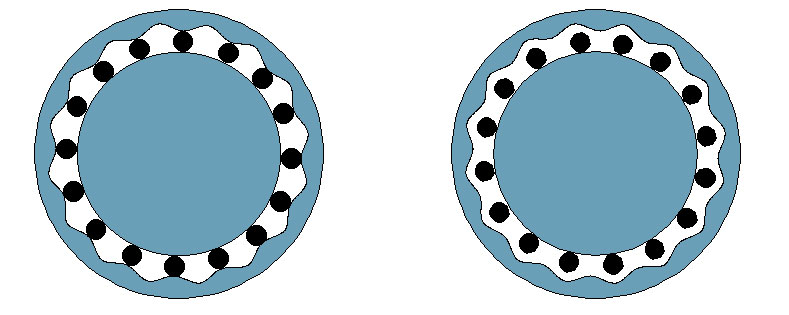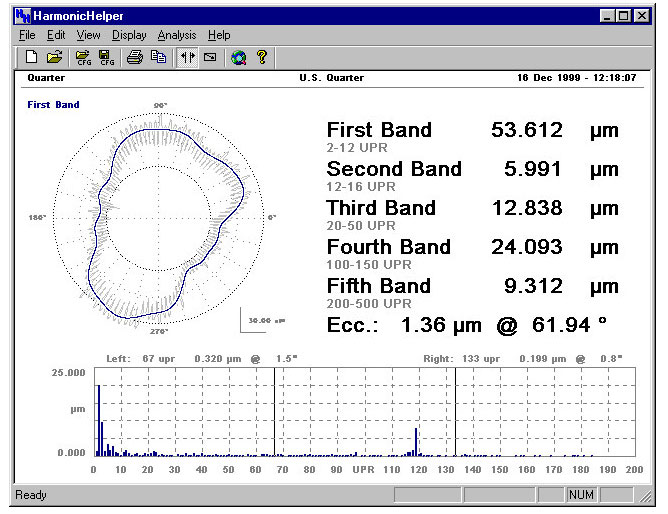Harmonic Helper
Harmonic analysis for roundness of rolling elements
Rolling element bearing raceways require tight controls on roundness in order to ensure proper performance. However, the typical specification of Peak-to-Valley roundness using standard filters and standard transmission bands does not necessarily control the roundness features that are related to performance implications such as noise and vibration. In these bearing applications, the “harmonic content” must be controlled. Or in other words, if the raceway may contains evenly spaced features that match up with the number of rolling elements performance problems can arise.

Analyzing bearing raceways
The common method for preventing (or at least “controlling”) this condition is to specify tolerances on specific frequency ranges. For example, if 16 elements are used, then the frequencies in the vicinity of 16 undulations per revolution (UPR) are analyzed. In some cases, multiples of this these frequencies are also analyzed.
While this approach is perfectly sensible in the context of rolling element bearings, it is somewhat outside the current practice for most commercially available roundness instruments. Typical instruments do not exactly meet the needs of this application due to any or all of the following factors:
The use of Gaussian or 2RC filters
- 2RC filters were employed in the first electronically based roundness instruments. This filtering approach exhibits very poor transmission characteristics and a serious problem due to “phase distortion.” This method is still available in most instruments, however it should not be used in light of better filtering approaches that are available.
- In recent years Gaussian filters have been standardized and are very useful in the common measurement of roundness. They provide a relatively “sharp” transmission characteristic and they do not generate phase distortions. However, in the context of analyzing specific frequencies their transmission characteristics are not sharp enough.
Fixed frequency bands
- Many instruments allow the user to select 15, 50, 150 or 500 UPR cutoffs. Relatively few provide a means for the user selection of arbitrary bands.
The display of only one “band” at a time
- The analysis of multiple harmonic bands is often desired in the analysis of raceways. Typical systems only allow for the display of a single frequency range.
The display of harmonic content is separated from the profile display
In many commercial applications, the roundness plot is readily displayed, but the display of harmonic information requires additional effort.
Introducing Harmonic Helper
Digital Metrology has developed a Harmonic Analysis package which can be readily incorporated with your Windows-based roundness measurement equipment. This software addresses the shortcomings described above through the following:
:: The incorporation of “harmonic” (also referred to as “brickwall” or “boxcar”) filters.
– This approach uses the Fourier transform as the basis for filtering whereby the desired frequencies are 100% retained and all others are set to zero.
Note: this is “ideal” in the frequency domain, but some “ringing” may occur in the spatial domain and therefore care must be taken to understand these effects.
:: Up to 5, user-selectable frequency bands.
– Harmonic Helper provides for the analysis of multiple frequency bands so that certain harmonic ranges and multiples of these ranges can be simultaneously analyzed.
No need to manually re-calculate and re-display data!
:: Simultaneous display of harmonic content and the measured profile.
– The Harmonic Helper display was engineer to provide ergonomics as well as maximum “information density”.
– The calculated results are large and bold.
– The raw data and one user-selected band are plotted on a scaleable polar graph.
– The harmonic content is plotted on a scaleable, interactive graph where cursors provide amplitude and phase information for user selected frequencies.

Putting Harmonic Helper to work for you
Harmonic Helper can run as a “stand alone” application allowing you to manually load and analyze data sets. Better yet, Harmonic Helper can run alongside your current Windows-based roundness application and can automatically load your measured data.
In today’s programmable roundness instruments you could write a measurement program that measures and saves the roundness profile to a specific location. Harmonic Helper can then be configured to monitor this file and when a new data set is available tit is automatically loaded into Harmonic Helper. Harmonic Helper will even bring itself to the top of the other windows (if you ask it to) when it automatically loads new data.
This ability to auto load and automatically bring the Harmonic Helper window to the top provides a very “clean” integration into a wide variety of programmable roundness measuring instruments. The operator is only required to load the component and run the measurement program (from within the instrument’s software). The instrument’s software then controls the measurement and saving of data. Harmonic Helper then automatically jumps into action, loads the new data and displays it.
There is no reason for advanced metrology tools to be difficult.
